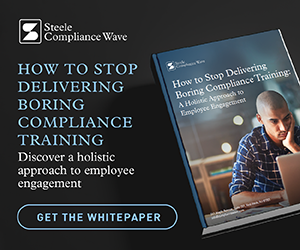Perhaps the most disturbing conversation I heard this year went as follows:
Me: “So what interaction do you have with your E&C team?”
Big cheese at Fortune 100 company: “Once a year I get an email from them listing who has not done their annual Code training.”
Me: “Ok”
Ok maybe not the most disturbing – I have two teenage children, but right up there. Sadly this was not an isolated event; so when did some E&C departments become events planners? Focusing on a few annual events, sending out invites, chasing RSVPs and following up on non-attendance. I have the good fortune to work with lots of outstanding E&C professionals and this is not what they signed up for.
How did we get to this position?
In many ways it is due to the success of the “E&C industry” and the push from regulators for visible programmes. However, from positive intentions it appears we have industrialized the E&C processes when what was really needed was to humanize it. We are overwhelmed with learning and content management systems that schedule, deploy, track and report on how our users are “progressing.” The sad reality is, that in many cases they are not progressing they are complying with a programme and in an age where increasingly what matters is what you measure this is deemed good enough.
So who is to blame?
A problem is much easier to understand if we can identify a miscreant and particularly if they’re not like us. But in the drive for process over effect we are all to some extent culpable. The regulators have set the tone - for example in the early days of anti sexual harassment training in California it was a requirement that employees spent two hours doing training every two years, so systems evolved to deliver this, exactly this. Business leaders like to be able to track and report – rightly so, but what we track are completions and confirmations, not understanding and commitment. Those of us in the E&C industry need to shoulder some of the responsibility, with some fantastic exceptions we have failed to successfully make the case for a better balance between process and completions and driving thoughtful E&C discussions. Discussions where teams can debate and grapple with their E&C ambitions and come to more considered and sincere commitments. There is much more compliance today than ever before but I’m not sure that there is less poor conduct. This is a challenge, but it is also the most enormous opportunity.
What can be done?
I’m not for one-minute advocating throwing out the systems and the measurements, they have a critical role to play. But we’re letting them dominate the heart of E&C too much. As a species we are at our core social beings; we emerge into this world with very limited capability and spend our formative years learning from the interactions happening with and around us and through this develop capability. When it comes to E&C we have to recognise the potential of the interactions we spark, we need to move from events to conversations and increase the frequency with which we have these discussions. We need to get happy with less control of every E&C conversation, but gaining more true reflection, discussion and mutual development of E&C commitments. We need to sell a more active role for all leaders and managers, not just by highlighting the downside management, but by leading with the release of discretionary effort and the increase of engagement levels when teams see an alignment of stated values and leadership actions. None of this means we lose annual sign-offs, strong process and controls, but they exist to support a companies working culture ambitions, not to define the culture..
So maybe the conversations goes:
Me: “So what interaction do you have with your E&C team?”
Big cheese at Fortune 100 company: “My team talks with them most weeks, we see them as key partners in enhancing our culture and therefore our performance. I have regular E&C discussions with my teams and I expect that of all our leaders. It’s a core capability for thriving here.”
Me: “You had me at my team talks.”




